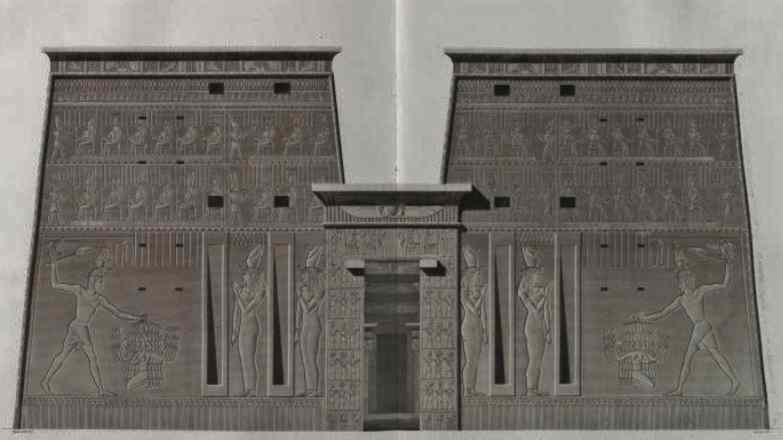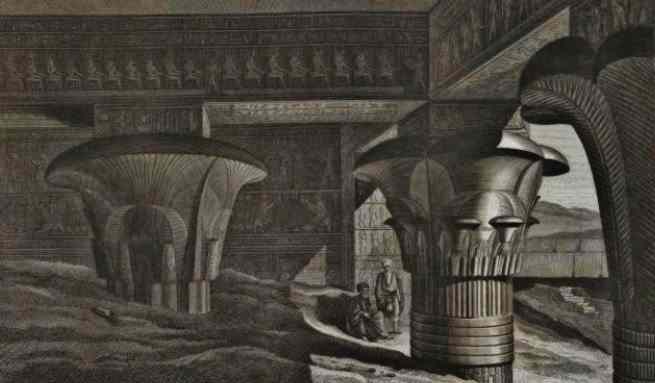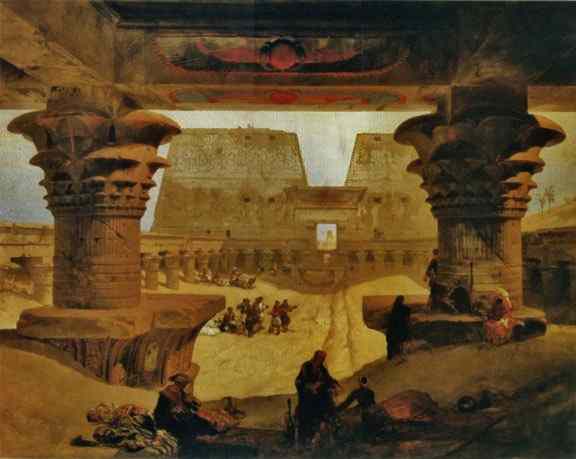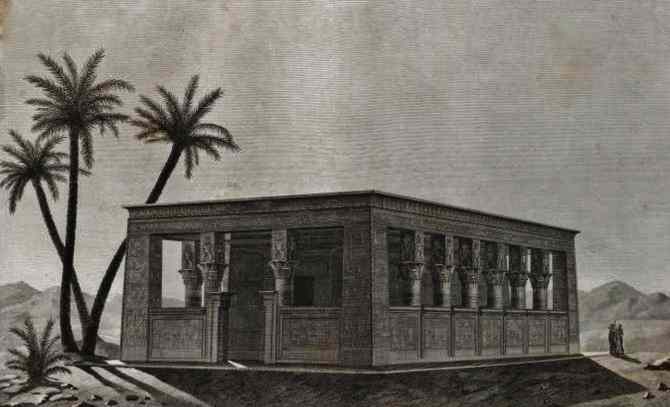AscendingPassage.com
See the: Egyptian Secrets Library.

The Temple at Edfu
All is within yourself.
Know your most inward self
and look for what corresponds with it in nature.
Isha Schwaller: "Her-Bak"
 The Spell of Egypt
The Spell of Egypt
by Robert Hichens, published 1911
(excerpt) -- EDFU --
Temple of the Hidden God.
There is one temple on the Nile which seems to embrace in its arms all
the worship of the past. A temple full of prayers and solemn praises. It is the noble keeper of the sacred longings, of the
unworldly desires and aspirations of Ancient Egypt. It is the temple of
Edfu (Edfou, formerly Appolinopolis). From all other temples it stands apart.
It is the temple of
inward flame, of the secret soul of man. It can touch that mystery within us
that is exquisitely sensitive, and exquisitely alive.

Re-creation of the Entrance Pylon of the Temple of Edfu
From "la Description de l'Egypte"
To Horus it was dedicated. Hawk-headed Horus, the son of
Osiris, was the young Apollo of
the old Egyptian world. But though I know this, I am never able to
associate Edfu with Horus.
Edfu, in its solemn beauty, in its perfection of form, seems to me to
pass into a region altogether beyond identification with the worship
of any special deity. Particular gods can be graven upon walls, and upon
architraves and pillars painted in brilliant colors. To
me, Edfu must always represent "the Hidden One".
Not Amun fused with Ra, with Amsu, or with Khnum:
but that other "Hidden One" with whom the Buddhist strives to merge his strange serenity
of soul.
Edfu is not pagan; it is
not Christian. It is a place in which to worship according to the
dictates of your heart.

The Temple of Edfu
By David Roberts, 1838
Edfu stands alone on the bank of the Nile between Luxor and Aswan. It
is not very far from El-Kab, once the capital of Upper Egypt, and it
is about two thousand years old. The building of it took over one
hundred and eighty years, and it is the most perfectly preserved
temple today of all Egypt. It is huge and it is splendid.
It has towers one hundred and twelve feet high, a propylon two hundred
and fifty-two feet broad, and walls four hundred and fifty feet long.
Begun in the reign of Ptolemy III., it was completed only fifty-seven
years before the birth of Christ.
You know these facts about it, and you forget them, or at least you do
not think of them. What does it all matter when you are alone in Edfu?
Let the antiquarian go with his anxious nose almost touching the
stone. Let the Egyptologist peer through his glasses at hieroglyphs
and puzzle out the meaning of cartouches. But let us wander at ease,
and regard the exquisite form, and drink in the mystical
spirit of this very wonderful temple.
Do you care about form? Here you will find it in absolute perfection.
Edfu is the consecration of form. In proportion it is supreme above
all other Egyptian temples. Its beauty of form is like the chiselled
loveliness of a perfect sonnet. While the world lasts, no architect
can arise to create a building more satisfying, more calm with the
calm of faultlessness, more serene with a just serenity.
Or so it
seems to me. I think of the most lovely buildings I know in Europe--of
the Alhambra at Granada, of the Cappella Palatina in the palace at
Palermo. And Edfu I place with them--Edfu utterly different from them,
more different, perhaps, even than they are from each other, but akin
to them, as all great beauty is mysteriously akin.
I have spent
morning after morning in the Alhambra, and many and many an hour in
the Cappella Palatina; and never have I been weary of either, or
longed to go away. And this same sweet desire to stay came over me in
Edfu. The boat Loulia was tied up by the high bank of the Nile. The
sailors were glad to rest. There was no steamer sounding its hideous
siren to call me to its crowded deck. So I yielded to my desire, and
long I stayed in Edfu. And when at last I left it I said to
myself, "This is a supreme thing," and I knew that within me had
suddenly developed the curious passion for buildings that some people
never feel, and that others feel ever growing and growing.

Yes, Edfu is supreme. No alteration could improve it. Any change made
in it, however slight, could only be harmful to it. Pure and perfect
is its design--broad propylon, great open courtyard with pillared
galleries, halls, chambers, sanctuary. Its dignity and its sobriety
are matchless.
I know they must be, because they touched me so
strangely, with a kind of reticent enchantment. I am not by nature
enamored of reticence and calm, but am inclined to
delight in almost violent force, in brilliance, and, especially, in
combinations of color.
In the Alhambra one finds both force and
fairylike lightness, delicious proportions, delicate fantasy, a spell
as of subtle magicians. In the Cappella Palatina, a jeweled splendor,
combined with a small perfection of form which simply captivates the
whole spirit and leads it to adoration.
In Edfu you are face to face
with hugeness and with grandeur, but soon you are scarcely aware of
either. Here these qualities somehow do not overwhelm the spirit and the
faculties. What you are aware of is your own immense and beautiful
calm of utter satisfaction. A calm which has quietly inundated you,
like a waveless tide of the sea.
How rare it is to feel this absolute
satisfaction, this praising serenity! The critical spirit goes like a
bird from an opened window. The excited, laudatory, voluble spirit
goes and this splendid calm is left. If you stay here, you will be molded into a beautiful sobriety as this
temple has been. From the
top of the pylon you have received this still and glorious impression
from the matchless design of the whole building, which you see best
from there. When you descend the shallow staircase, when you stand in
the great court, when you go into the shadowy halls, then it is that
the utter satisfaction within you deepens. Then it is that you feel
the need for silence in this place created for worship.
The ancient Egyptians made most of their temples in conformity with a
single type. The sanctuary was at the heart, the core, of each temple. The sanctuary was surrounded by the chambers in which were laid up the
precious objects connected with ceremonies and sacrifices. Leading to
this core of the temple were various halls the roofs of which were supported by
columns--those hypostyle halls which one sees perpetually in Egypt.

The First Pylon, from the courtyard, Edfou Temple
From "la Description de l'Egypte".
Before the first of these halls was a courtyard surrounded by a
colonnade. In the courtyard the priests of the temple assembled. The
people were allowed to enter the colonnade. A gateway with towers gave
entrance to the courtyard.
If one visits many of the Egyptian temples,
one soon becomes aware of the subtlety, combined with a sort of high
simplicity and sense of mystery and poetry, of these builders of the
past. A great writer leads one on, with a concealed but beautiful
art, from the first words to which all the other words are ministering
servants. A great musician leads one from the first notes of his score to those final
notes which magnificently reveal to the listeners the real meaning of
those first notes, and of all the notes which follow them. So the
Egyptian builders lead the spirit gently, mysteriously forward from
the gateway between the towers to the distant house divine.
When one
enters the outer court, one feels the far-off sanctuary. Almost
unconsciously one is aware that for that sanctuary all the rest of the
temple was created; that to that sanctuary everything tends. And in
spirit one is drawn softly onward to that very holy place.
Slowly,
perhaps, the body moves from courtyard to hypostyle hall, and from one
hall to another. Hieroglyphs are examined, cartouches puzzled out as one walks along. Paintings of processions, or bas-reliefs of pastimes and of
sacrifices are looked at with care and interest, but all the time one has
the sense of waiting, of a want unsatisfied. And only when one at last
reaches the sanctuary is one perfectly at rest. For then the spirit
feels: "This is the meaning of it all."
One of the means which the Egyptian architects used to create this
sense of approach is very simple, but perfectly effective. It
consisted in making each hall on a very slightly higher level
than the one preceding it, and the sanctuary, which is narrow and
mysteriously dark, on the highest level of all.
 Each time one takes an
upward step, or walks up a little incline of stone, the body seems to
convey to the soul a deeper message of reverence and awe. In no other
temple is this sense of approach to the heart of a thing so acute as
it is when one walks in Edfu. In no other temple, when the sanctuary
is reached, has one such a strong consciousness of being indeed within
a sacred heart.
Each time one takes an
upward step, or walks up a little incline of stone, the body seems to
convey to the soul a deeper message of reverence and awe. In no other
temple is this sense of approach to the heart of a thing so acute as
it is when one walks in Edfu. In no other temple, when the sanctuary
is reached, has one such a strong consciousness of being indeed within
a sacred heart.
The color of Edfu is a pale and delicate brown, warm in the strong
sunshine, but seldom glowing. Its first doorway is extraordinarily
high, and is narrow, but very deep, with a roof showing traces of that
delicious clear blue-green which is like a thin cry of joy.
In the court, upon a pedestal, stands a big bird, and
near it is another bird, or rather half of a bird, leaning forward,
and very much defaced. And in this great courtyard there are swarms of
living birds, twittering in the sunshine. Through the doorway between
the towers one sees a glimpse of a native village with the cupolas of
a mosque.
I stood and looked at the cupolas for a moment. Then I turned, and
forgot for a time the life of the world without. For
when I turned, I felt, as I have said, as if all the worship of the
world must be concentrated here.

Inside the Temple of Edfu
From "la Description de l'Egypte"
Standing far down the open court, in
the full sunshine, I could see into the first hypostyle hall, but
beyond only a darkness--a darkness which led me on, in which the
further chambers of the house divine were hidden. As I went on slowly,
the perfection of the plan of the dead architects was gradually
revealed to me. I saw not
clearly, but dimly, the long way between the columns, the noble
columns themselves, the gradual, slight upward slope. Gracefully my steps led to the sanctuary, seen at
last as a little darkness. All the mystery of worship, and of
the silent desires of men, was surely concentrated, and kept there by the
stone for ever.
Even the succession of the darknesses, like shadows
growing deeper and deeper, seemed planned by some great artist in the
management of light and of shadow effects. The perfection of form
is in Edfu, impossible to describe, impossible not to feel. The
tremendous effect it has--an effect upon the soul--is created by a
combination of shapes, of proportions, of different levels, of
different heights, by consummate graduation.

Pharaoh is blessed by goddesses
wearing the crowns of Upper and Lower Egypt.
Photo by Henri Bechard
And these shapes,
proportions, different levels, and heights, are seen in dimness. Not
that jewelled dimness one loves in Gothic cathedrals, but the heavy
dimness of windowless, mighty chambers lighted only by a rebuked
daylight ever trying to steal in. One is captured by no ornament,
seduced by no lovely colors. Better than any ornament, greater than
any radiant glory of color, is this massive austerity.
It is like the
ultimate in an art. Everything has been tried, every strangeness, absurdity, every wild scheme of hues, every preposterous
subject. At the end a genius
writes a little song, and the world gives the tribute of its
breathless silence and its tears. And it knows that though other
things may be done, better things can never be done. For no perfection
can exceed any other perfection.

Edfu Courtyard.
In later life David Roberts sometimes created
oil versions of the subjects of his earlier engravings.
And so in Edfu I feel that this untinted austerity is perfect; that
whatever may be done in architecture during future ages of the world,
Edfu, while it lasts, will remain a thing supreme--supreme in form
and supreme in the spell which it casts
upon the soul.
The sanctuary is just a small, beautifully proportioned, inmost
chamber, with a black roof. It contains a sort of altar of granite and
a great polished granite shrine which no doubt once contained the god
Horus. I am glad he is not there now. How far more impressive it is to
stand in an empty sanctuary in the house of "the Hidden One",
like those who gaze at the snow-
white plume that floats from the snows of Mount Etna under the rose of dawn,
and feel the soul behind Nature. Among the temples of Egypt, Edfu is perfect.
Excerpt from: The Spell of Egypt
by Robert Hichens, published 1911.
Etext prepared by Dagny
and John Bickers.
Adapted for AscendingPassage.com.
NEXT CHAPTER

Re-creation of the smaller Temple at Edfu
from La Description de l'Egypte, 1809
~~~~~~~~~~~~~~~~~~~~~~~~~~~~~~~~~~~~~~~~~~~~~~~~~~~~~~~~~~~~~~~~~~~~~~~~

Hadjar Silsilis, North of Kom Ombo
By David Roberts, 1839.
Silsilis

Excerpted from
The land of the Pharaohs
By Samuel Manning
A few hours after leaving Edfu we reach Silsilis, (Silsila), which is interesting
as being the quarry from which the stone was cut for the temples and
palaces of Thebes (100 miles downriver). The excavations are of immense extent on both sides
of the river, which is here very narrow.
The tool-marks of the masons, made three
thousand years ago, are distinctly visible, and it is easy to see the methods
employed to separate the huge blocks of stone, in the absence of gunpowder
or other explosive material. Wooden wedges were inserted into the rock,
and then moistened. As the line of wedges swelled, a mass of stone was
detached of the size required.
(Right) Silsilis, by Samuel Manning, author of this excerpt, 1875.

Carved shrines of the quarrymen of Silsila.
from La Description de l'Egypte, 1809.
Remembering the stir and bustle of which
these quarries were once the scene, their present solitude and silence are
most impressive. Facing the river are a number of small grottoes or chapels,
apparently for the use of the quarrymen, and these, with the buttresses of
stone carved into the form of columns, have a very picturesque appearance,
giving the impression of a vast city hewn out of the living rock.
"The land of the Pharaohs"
illustrated by pen and pencil.
By Samuel Manning.
Machine-readable version: TechBooks.
Digital images, parsing and proofing:
Electronic Resources Center,
Fondren Library, Rice University.
Publisher: Rice University, Houston, Tx, 2006
Identifier: TIMEA, ManLand
Publicly available via the
Travelers in the Middle East Archive (TIMEA)
through the Creative Commons attribution license.
~~~~~~~~~~~~~~~~~~~~~~~~~~~~~~~~~~~
Additional images by Vivant Denon and David Roberts.

Countless beautiful 19th century images of ancient Egypt
and 75 pages of architecture, art and mystery
are linked from the library page:

The Egyptian Secrets Library



 The Spell of Egypt
The Spell of Egypt












